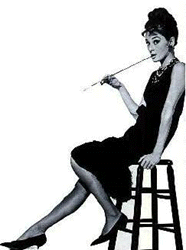

Contemporary movies seem obsessed with the division between stylized entertainment fictions and the dark insecurities of life in the "real world," epitomized by films like The Truman Show or Pleasantville. But in the early sixties, stylized comedies presented the perfect glass through which to view the glamorous world of the rich and affluent. Blake Edward's masterpiece Breakfast at Tiffany's magically captures the air of an age and style long gone by.
Style is the foremost concern in Holly Golightly's Manhattan existence. The bright eyed and beautiful Audrey Hepburn - whose accent always sounds slightly phony - performs flawlessly as Holly, a girl who's obsessed with surface appearances. As her agent says, the only real thing about Holly is her phoniness.

Holly identifies herself as a wild girl, unwilling to be tied down to men who wish only to posses or control her. Though largely un-self aware of her neuroses and desires, she understands that in a world obsessed with money, beautiful women are only another commodity. She divides the men she dates into rats, super-rats, and scared little mice; either afraid of her, or after her only for sex.
The promise of true love comes from Paul Varjak (George Peppard), a next door neighbor also selling himself for money. Where Holly dates rich rats only for their lavish monetary gifts, Paul prostitutes himself to a rich socialite patron. A fledgling writer who shows great promise, Paul writes short stories rather than novels, and seems unable to live up to his reviews, nor sell books.
It is obvious from the beginning that Holly and Paul will eventually end up together; the movie concerns itself less with their romance and more with their growing maturity. The swinging party life of upper crust Manhattanites is shown to be absurd in its extreme and lavish immaturity, hollow of real emotional value or connection. When money, sex and parties are the basic values of social interaction, deeper inner fulfillment is rarely found.
Holly, a more developed character than Paul, continually shifts between shallow empty headedness and hints of a deeper, repressed sense of emotion. Coming from a troubled family life, Holly fears letting her guard down. She places her social goals, gaining wealth and popularity, above her emotional needs, and suffers bizarre mood swings as a result.
Paul, used to being taken care of by his mistress, only wants to protect Holly like a child. Their growth to give into their feelings and relax around one another is as enjoying and entertaining as a love story could be.
The film presents many metaphors and intellectual issues of psychology and class to contemplate. Yet these themes are immersed within the bright pastels of the setting, the bouncy lounge music of Henry Mancini's Oscar winning score, and the slapstick sequences of Blake Edwards' humor.
Like Edwards' Pink Panther series, Breakfast at Tiffany's provides a subtle social critique, and a surprisingly smart film hidden behind its light facade. This comes as no surprise considering that the story stems from a novella by Truman Capote, an author who strove for both intellectual acclaim and popular acceptance.
The stereotyped sequences involving Mickey Rooney as an Asian man living in Holly's building date the film, and must be taken with a grain of salt. Otherwise, this film remains surprisingly fresh and relevant.
But whereas today's movies heighten the sense of disparity between fiction and reality, Breakfast at Tiffany's offers the hope that if one follows their heart, true happiness can be found. Today's cynic can only wonder if perhaps this is the greatest fiction of them all, but its this fantastic, cinematic and un-ironic quality which makes Breakfast at Tiffany's such a lovely movie.
Breakfast at Tiffany's is showing this Sunday through OFS.
Copyright © 1999, The Oberlin Review.
Volume 127, Number 19, April 9, 1999
Contact us with your comments and suggestions.